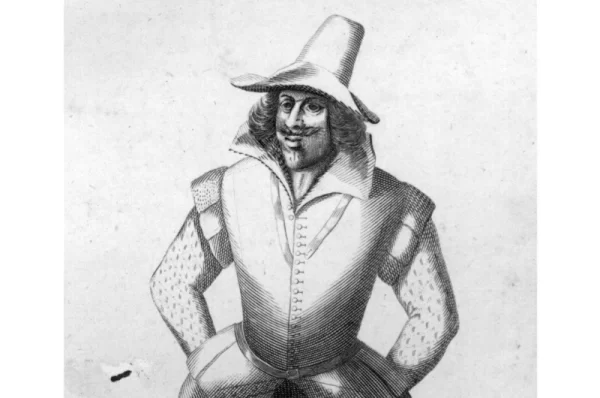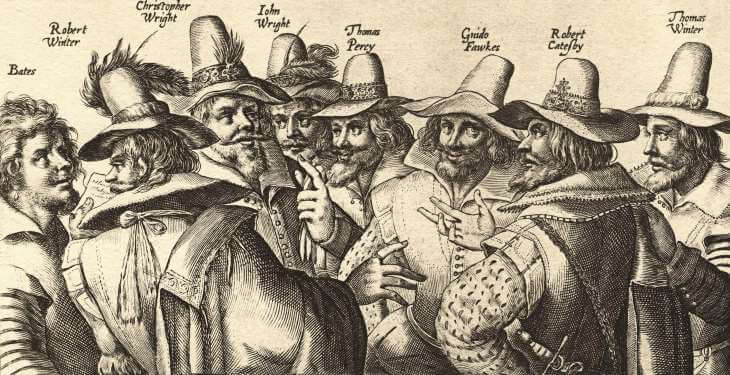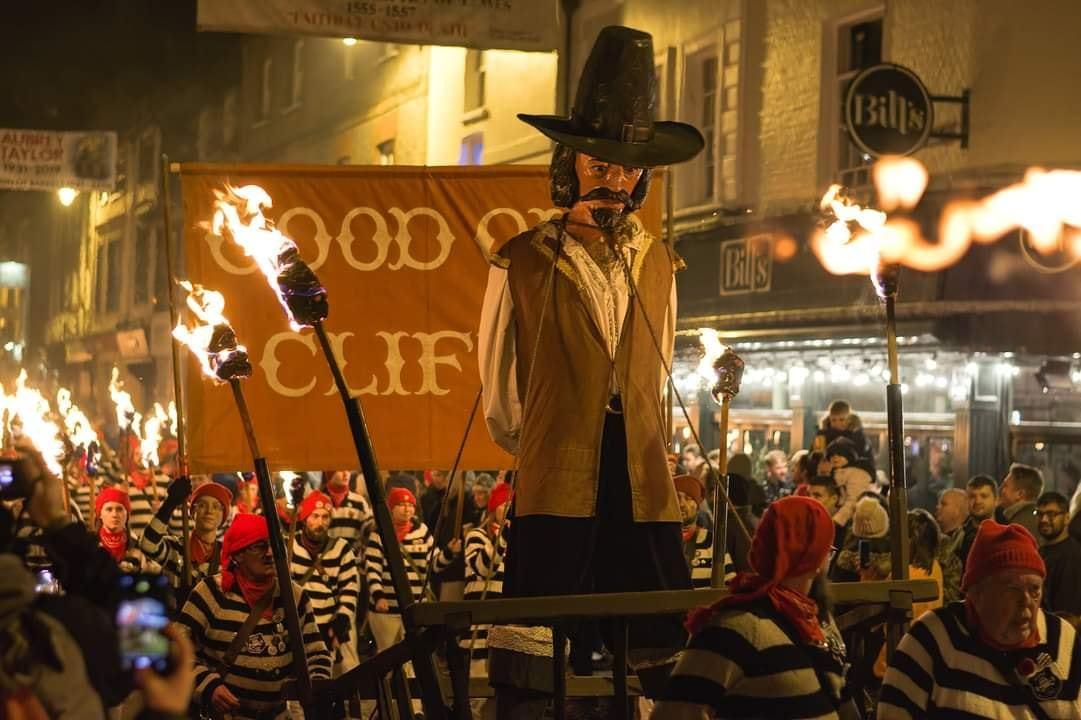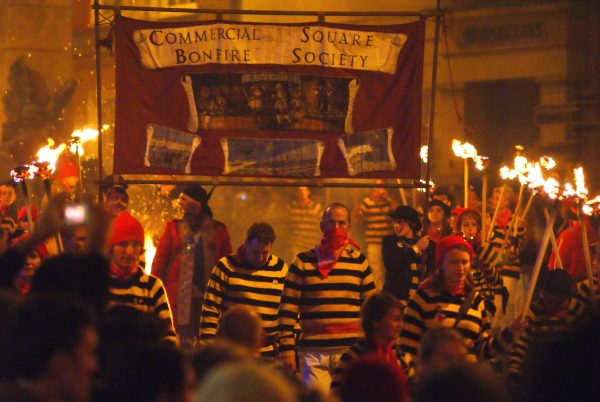Remember, remember the Fifth of November,
The Gunpowder Treason and Plot,
I know of no reason
Why the Gunpowder Treason
Should ever be forgot.
Guy Fawkes, Guy Fawkes, t’was his intent
To blow up the King and Parli’ment.
Three-score barrels of powder below
To prove old England’s overthrow;
By God’s providence he was catch’d
With a dark lantern and burning match.
Holla boys, Holla boys, let the bells ring.
Holloa boys, holloa boys, God save the King!
And what should we do with him? Burn him!
In the early seventeenth century, Catholics were faced by a difficult choice, support your country or support your faith. Catholics who would not conform to the rules laid down by the state and Anglican establishment, and attend Church of England services, were known as recusants. Some refused to conform to the state’s legislation and instead recused themselves from the government-imposed beliefs, worship, and practice.
Laws were passed from the 1530s onwards restricting how Catholics could worship and practice their faith. A brief respite from royal disapproval came during the reign of Queen Mary, but the reign of Queen Elizabeth brought even more harsh and punitive laws. When Queen Elizabeth I came to the throne in 1559, she set herself against the Pope by declaring herself ‘Supreme Governor’ of the English church in matters spiritual and temporal and denouncing loyalty to the Bishop of Rome as an act of treason. Thenceforth, all Christians in the realm were required to follow the state religion or suffer the consequences. Catholicism and treason were seen by some in the Privy Council as synonymous. Under the early guidance of Secretary of State Sir William Cecil, Elizabeth repealed Mary’s pro-Catholic legislation, established a permanent Protestant Church of England, and encouraged the Calvinist reformers in Scotland.
In 1570, Pope Pius V issued the bull Regnans in Excelsis, which excommunicated Queen Elizabeth I, deprived her of her right to rule, and released her subjects from obedience to her. This had the effect of antagonising Elizabeth and confirming her opinion of the Roman church. It also led to suspicion of, and bad feeling about, Catholics within the kingdom. During her reign, dozens of priests were put to death, and Catholics could not even legally attend Mass or be married according to their own rites, nor teach their children the essentials of the faith.
As a result, many Catholics had high hopes when King James I took the throne following Elizabeth’s death in 1603. James’ wife, Anne, is believed to have previously converted to Catholicism, and his mother Mary Queen of Scots, was Elizabeth’s Catholic arch-rival prior to being executed. There were even rumours, inspired by his communications with the Pope, that James himself would become Catholic. It soon became clear, however, that James did not support religious tolerance for Catholics. In 1604, he publicly condemned Catholicism as a superstition, ordered all Catholic priests to leave England, and expressed concern that the number of Catholics was increasing. He also largely continued with the repressive policies of his predecessor, such as fines for those refusing to attend state church services. English Catholics had organised several failed conspiracies against Elizabeth, and these continued under James.
This is the background to the Gunpowder Plot. Fawkes’ legacy is arguably now that he is seen as a symbol for resisting ‘oppression’ by authoritarian regimes. This symbol has been perpetuated by the V for Vendetta film in 2005. The Guy Fawkes mask is now sometimes worn by the disaffected and disillusioned in modern society at rallies and protests in cities across the world.
So, was Fawkes a hero or a villain? Should we reevaluate his legacy in the light of modern scholarship, free from the obvious bias of later historians following the discovery of the plot? Was he the victim of a cruel and tyrannical regime, or a freedom fighter struggling for human rights at a time when human rights, freedom of religion, freedom of assembly and freedom of speech were not tolerated?
Observed in the United Kingdom every year on November 5, Guy Fawkes Day, also known as Bonfire Night or Fireworks Night, commemorates the failed assassination attempt on the king and parliament. On November 5, 1605, Guy Fawkes and a group of radicalised English Catholics tried to assassinate King James I by blowing up Parliament’s House of Lords.
The plot went awry, and all the conspirators were subsequently executed. Soon after, English people began to celebrate Fawkes’ demise and the survival of their king by burning effigies, lighting bonfires and setting off fireworks, a tradition which has continued to this day. Yorkshireman Guy Fawkes, was discovered about to ignite 36 barrels of gunpowder underneath the Houses of Parliament. His aim was to spark a Catholic revolution.
Fawkes was born in York in 1570, probably at a house in Stonegate. He was baptised in St. Michael-Le-Belfrey Church on April thirteenth of that year. His father Edward, a church lawyer and a prominent Protestant in the city, died when Guy was only eight years old. His mother remarried, this time to a Catholic, and they moved to the village of Scotton, near Knaresborough. Fawkes, by now a Catholic, continued his schooling in York, at St Peter’s. His schoolmates included brothers John and Christopher Wright, who were later destined to join the gunpowder plot. Christopher, or ‘Kit,’ was the same age as Guy Fawkes.
In the late sixteenth century, York was seen as a centre of the Catholic resistance. About the time that Fawkes himself converted, he would have been aware of a particularly brutal example of the religion’s suppression. In 1586, Margaret Clitherow, a housewife and butcher’s wife from the Shambles, was executed by being pressed to death for refusing to plead on the charge of allowing Priests in her home. When he came of age, Fawkes inherited property in York, at Gillygate and Clifton. On his 21st birthday, Fawkes, who by now must have hated the oppressive regime he had had to live under, sold his estate and enlisted in the Spanish army. He spent the next 10 years fighting for Spain in the Netherlands, becoming commander of a unit of soldiers and an expert in explosives (Fig. 1).

According to writings in the Spanish archives, Fawkes believed the English king was a heretic who would drive out his Catholic subjects. Fawkes also apparently expressed strong anti-Scottish prejudices. The king was Scottish. Fawkes also personally petitioned the king of Spain for help in starting an English rebellion against James.
In Madrid, Fawkes met up again with Kit Wright and they joined a group of conspirators, who together plotted to murder King James and replace him with a Catholic monarch. In 1603 a few priests and laymen hatched the so-called Bye Plot to kidnap James, only to be turned in by fellow Catholics. Another related conspiracy that year, known as the Main Plot, sought to kill James and install his cousin on the throne.
The plan was audacious and brutal. The plotters decided to hire a cellar under the Parliament house and smuggle in the barrels of gunpowder. Fawkes stood guard. It was his role, as an explosives expert, to light the fuse, then head to Flanders to raise forces who would join in the Catholic uprising in England. After his arrest in the cellar under the parliament house, Guy was tortured by the authorities. His schoolfellows, John and Kit Wright, died in November 1605 when they were caught with other conspirators at Holbeche House in Staffordshire (Fig. 2). Then, in January 1606, Guy Fawkes himself was put to death in Westminster by hanging, drawing and quartering. His remains were sent to the four corners of the Kingdom as a warning to other plotters.

Then, in May 1604, a handful of Catholic dissidents (Guy Fawkes, Robert Catesby, Tom Wintour, Jack Wright and Thomas Percy) met at the Duck and Drake Inn in London, where Catesby proposed a plan to blow up the Houses of Parliament with gunpowder. Afterwards, all five men reputedly swore an oath of secrecy upon a prayer book. Eight other conspirators would later join what later became known as the Gunpowder Plot. But although Catesby was the ringleader, Fawkes has gained most of the publicity over the past 400 years. He also used the alias John Johnson while serving as caretaker of a cellar which was located just below the House of Lords, which the plotters had leased in order to stockpile gunpowder.
Under the plan, Fawkes would light a fuse on November 5, 1605, during the opening of a new session of Parliament. James, his eldest son, the House of Lords and the House of Commons would all be blown sky-high. In the meantime, as Fawkes escaped by boat across the River Thames, his fellow conspirators would start an uprising in the English Midlands, kidnap James’ daughter Elizabeth, install her as a puppet queen, and eventually marry her off to a Catholic, thereby restoring the Catholic monarchy.
It was, of course, ill thought out, foolish and above all, doomed to failure. The plot soon began to unravel. On October 26, an anonymous letter advising a Catholic sympathiser to avoid the State Opening of Parliament, alerted the authorities to the existence of a plot. To this day, no one knows for sure who wrote the letter. Some historians have even suggested that it was fabricated and that the authorities already knew of the Gunpowder Plot, only letting it progress as an excuse to further crack down on Catholicism. This seems the most probable and likely theory, as Lord Cecil’s spies and informers must have had some warning of the plot to overthrow the monarchy and parliament. If not, they had failed in their duty to the king. Either way, a search party apparently found Master Fawkes in the cellar below parliament, around midnight, with matches in his pocket and 36 barrels of gunpowder stacked next to him.
For Fawkes, the plot’s failure could be blamed on, “the devil and not God.”1 He was taken to the Tower of London and tortured on the special order of King James. Under interrogation, he stated that a dangerous disease required a desperate remedy. Soon after, his co-conspirators were also arrested, except for four, including Catesby, who died in a shoot-out with the king’s troops. Or so the official story goes.
Fawkes and his surviving co-conspirators were all found guilty of high treason and sentenced to death in January 1606 by hanging, drawing and quartering. A Jesuit priest was also executed a few months later for his alleged involvement, even as new punitive, anti-Catholic laws banned Catholics from voting in elections, practicing law or serving in the military. In fact, Catholics were not fully emancipated in England until the nineteenth century.
After the plot was revealed, Londoners began lighting celebratory bonfires, and in January 1606 an act of Parliament designated November fifth as a day of thanksgiving. This replaced the earlier festival of Halloween at the end of October which with its remembrance of All Saints and All Souls, was regarded by some in the Privy Council as too Popish. A new secular festival was proposed. In keeping with the anti-Catholic sentiment of the time, people were encouraged to burn an effigy of the Pope. Guy Fawkes Day became a time to get together with friends and family, set off fireworks, light bonfires, attend parades, burnish ones Protestant credentials whilst burning effigies of Fawkes.
Later, children traditionally wheeled around their effigies demanding a “penny for the Guy” and asking crowds to “remember, remember the fifth of November.” This practice continued well into the twentieth century and may still be observed in some areas of the country. The focus was upon anti-popery; the effigies that were burnt on the bonfire on the fifth usually resembled the Pope until a development later, in the nineteenth century, which saw the ‘guy’ burnt on the bonfire. Burning an effigy of a respected religious leader would be seen as extremely politically incorrect in twenty-first century England, though possibly not so in Northern Ireland.
In Lewes, East Sussex, on the left bank of the River Ouse there is a large chalk cliff known as Cliffe Hill, that can be seen for many miles. A monument is clearly visible on the skyline, and it is this monument, a granite obelisk, thirty-five feet in height, that marks the passing of seventeen men and women who were burned to death for their faith.
In Lewes today, each bonfire society marches in costume carrying fiery torches which release smoke into the air. Several are accompanied by bands (Fig. 3). Local brass bands. Drum bands. Pipe bands. And the regular punctuation of whistles, rowdy singing and the loud cracks of bangers and fireworks. There are impressive-looking costumes of Vikings, pirates in tricorn hats, French revolutionaries, Tudors, Victorian Firemen and people in stripey shirts. The main bonfire societies are locally based and Lewes itself has six, including Nevill Juvenile, Waterloo, Borough, Commercial Square, South Street and Cliffe.

The Cliffe Bonfire Society is said by some to be the most extreme, or alternatively the most authentic and traditional of the bonfire societies in Lewes area. Historically, the Society burned the traditional effigies of Pope and Fawkes and were frequently accompanied into the fire by local notorieties or opponents of British interests in the world. Following World War I, the Society resurrected its celebrations, retaining all the traditional elements including the “No Popery” banner and the burning of an effigy of the Holy Father. During the 1920s, the Society withstood constant criticism for this practice. When, in 1933, the then-Mayor, J.C. Kenward, wrote requesting that the Society discontinue the offending effigy, it declined.
The Society’s determination to maintain the true bonfire traditions of the Fifth led to its being ostracised by the other Lewes bonfire societies. In the 1950s, the Bonfire Council attached pre-conditions to Cliffe’s participation in the United Grand Procession, the Society being permitted to join only if the “No Popery” banner was not carried. Cliffe rejected this offer, and while it now plays a full part in the Lewes Bonfire Council’s activities, the Society has maintained its independence by refusing to join the ‘United’ procession.
Many might argue that there is nothing wrong with positive remembrance of those who were persecuted for their faith. But burning an effigy of what is said to be a Pope, the head of a worldwide church, could be seen as a scandalous piece of bigotry, especially when one of the bonfire societies in the town, Cliffe, paraded under a “No Popery” banner as late as 2013. Mindful of its obligations under the Equalities Act, Lewes District Council euphemistically described the event as: a ‘key part of community culture.’ Speaking ahead of the 2020 event, Keith Austin, a former secretary of the Lewes Bonfire Council, said: “I always tell people that Lewes is not anti-Catholic. It’s more pro-Protestant. In ‘Bonfire’ there are a lot of Catholic people. It’s about history. There’s nothing sinister about it.”2 Some members of the Lewes Bonfires Societies would no doubt defend the Lewes Bonfire as a largely harmless, although arguably, tasteless, event (Fig. 4).

Although they rejoined the Bonfire Council in the 1970s, the separation remains. The Cliffe Bonfire Society march, proud and alone, under their banner at the bottom of town. The question of whether the event offends Catholics continues, as seen in a November 3, 2003 article published in Brighton newspaper The Argus.
“Joe O’Keefe, 51, of Newick, Lewes, has written to the head of Sussex Police demanding the annual event be scrapped on the grounds it is offensive to his religion. He also wants to ban the burning crosses and No Popery signs carried through the town’s streets every November 5. In the letter sent yesterday, Mr O’Keefe asked Sussex Police Chief Constable Ken Jones for his help to ‘stop this religious bigotry once and for all.’ He also wants to ban the burning crosses and No Popery signs carried through the town’s streets every November 5. He wants police to prosecute bonfire societies which take part in the celebrations for inciting racial or religious hatred under the Crime and Disorder Act. Mr. O’Keefe decided to act following Sussex Police’s investigation of a bonfire society which set fire to effigies of a family of travellers. The force has arrested ten people in connection with the controversial Firle bonfire celebration near Lewes on October 25… Mr. O’Keefe, a company director, said: ‘This religious bigotry belongs in the past. Many Catholics stay away from Lewes on November 5 because they find it insulting. There are burning crosses and No Popery chants—if it was a gipsy or black person they were burning it would not be allowed.’ Mr. O’Keefe said he did not want bonfires or fireworks banned. He said: ‘What I don’t want is to see any form of racial or religious antagonism in the evening. It’s a form of harassment and very offensive to Roman Catholics.”3
Keith Austin, secretary of Lewes Bonfire Council, reportedly responded, “We don’t carry out these celebrations with any hate or bigotry. It’s a reminder of the days when people weren’t allowed to pursue their religion. We wish Mr. O’Keefe well to pursue his religion. Burning crosses is not anti-religious. The crosses are to remind people of the seventeen martyrs who lost their lives in Lewes by being burnt at the stake outside the town hall.”4
Nationally, the figure of Guy Fawkes, or the ‘guy,’ is still occasionally burnt as he is the figure most associated with the plot, perhaps as he remained the only known suspect for a number of weeks. Yet recent developments in the last few years have seen a disassociation of Fawkes and the ‘guy’ in the commemoration of Bonfire Night and indeed the ‘guy’ with the Fifth generally, as it is now more common to light fireworks instead. The dissociation of Fawkes and the body of the ‘guy’ with Bonfire Night represents a loss in the association of treason with Fawkes. Many children today may have little understanding who Guy Fawkes really was, let alone what he was accused of doing, and the background of persecution which lay behind the Gunpowder Plot. Arguably, comparatively few ordinary folk in Lewes today might be able to explain what a Protestant is, let alone what Protestants might or might not believe. It could be argued that religious faith has largely lost its hold on ordinary people and the religious arguments of the past are largely lost in the mists of history.
But what would the reaction be if that burning guy was an image of a Muslim, Jew, transgender, or gay figure? What would happen if they tried to burn an image of the Prophet Muhammad? That would be a very different outcome. Equalities legislation is intended to protect minorities from discrimination and abuse. To have anti-Catholic bigotry paraded openly, whether it is dressed up as pseudo-history or not, would not be acceptable if it affected any other minority community. Bonfire Night attracts up to sixty thousand towns folk and visitors to the narrow streets of Lewes with flaming torches, prompting organisers to warn the event is not suitable for young children. One could argue that it is not a very comfortable festival for historically-minded Catholics either.5
Elsewhere, in modern times, Guy Fawkes has undergone something of a makeover. Once largely seen as a notorious traitor, he is now portrayed in some circles as a revolutionary hero, largely due to the influence of the 1980s graphic novel V for Vendetta and the 2005 film of the same name, which depicted a hero who wore a Guy Fawkes mask while battling a future fascist government in Britain. Guy Fawkes masks even cropped up during other protests. “Every generation reinvents Guy Fawkes to suit their needs.”
Perhaps, with hindsight, the whole episode of gunpowder, treason and plot should now be forgotten and consigned to the bonfire of history. However, we, as a diverse, inclusive, multicultural society, must learn from past mistakes and look to the future rather than back at a troubled and unsettled time in our history when to be a Catholic was to be seen by some as a dangerous and disloyal subject of the crown.
FOOTNOTES
1. Fraser, The Gunpowder Plot, 209.
2. Meagher, Kevin. “Bonfire Night bigotry is alive and well in Lewes.” Left Foot Forward, Nov 5 2012. leftfootforward.org/2012/11/bonfire-night-bigotry-lewes/.
3. Not Stated. “Call for end to pope-burning tradition.” The Argus, Nov 17, 2003. theargus.co.uk/news/5100833.call-for-end-to-pope-burning-tradition/.
4. Ibid.
5. Meagher, Kevin. “Bonfire Night bigotry is alive and well in Lewes.”
Sources Cited
Childs, Jessica. God’s Traitors: Terror and Faith in Elizabethan England. London: Vintage, 2015.
Childs, Nick. “Bonfire bigotry lives on in Sussex – it’s time we took a stand.” Brighton & Hove News, Nov 4, 2021. brightonandhovenews.org/2021/11/04/bonfire-bigotry-lives-on-in-sussex-its-time-we-took-a-stand/.
Etherington, Jim. “A Brief History of Cliffe Bonfire.” Cliffe Bonfire, 2003. cliffebonfire.com/a-brief-history-of-cliffe-bonfire/.
Fraser, Antonia. The Gunpowder Plot: Terror and Faith in 1605. London: Phoenix, 1996.
Johanesen, Sarah. “Silken Priests: Catholic Disguise and Anti-Popery on the English Mission 1569-1640.” On History, Apr 9, 2020. blog.history.ac.uk/2020/04/silken-priests-catholic-disguise-and-anti-popery-on-the-english-mission-1569-1640/.
Lula, Muneera. “Hero or Villain? Guy Fawkes.” Manchester Historian, Dec 9 2015. manchesterhistorian.com/2015/hero-or-villain-guy-fawkes/.
Meagher, Kevin. “Bonfire Night bigotry is alive and well in Lewes.” Left Foot Forward, Nov 5 2012. leftfootforward.org/2012/11/bonfire-night-bigotry-lewes/
Not Stated. “Call for end to pope-burning tradition.” The Argus, Nov 17, 2003. theargus.co.uk/news/5100833.call-for-end-to-pope-burning-tradition/.
Not Stated. “No Popery Banner – Lewes Bonfire Night Celebrations.” Lewes Bonfire Celebrations, Oct 22, 2013. lewesbonfirecelebrations.com/article/history-of-lewes-no-popery-banner/.
Cover Photo by Peter Trimming/Geograph. Licensed under C.C. 2.0 license.
